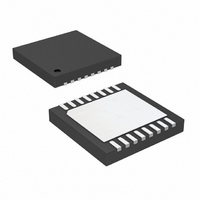LT3021EDH#TRPBF Linear Technology, LT3021EDH#TRPBF Datasheet - Page 13

LT3021EDH#TRPBF
Manufacturer Part Number
LT3021EDH#TRPBF
Description
IC REG LDO ADJ 500MA 16-DFN
Manufacturer
Linear Technology
Datasheet
1.LT3021ES8PBF.pdf
(16 pages)
Specifications of LT3021EDH#TRPBF
Regulator Topology
Positive Adjustable
Voltage - Output
0.2 ~ 9.5 V
Voltage - Input
0.9 ~ 10 V
Voltage - Dropout (typical)
0.155V @ 500mA
Number Of Regulators
1
Current - Output
500mA
Current - Limit (min)
550mA
Operating Temperature
-40°C ~ 125°C
Mounting Type
Surface Mount
Package / Case
16-DFN
Lead Free Status / RoHS Status
Lead free / RoHS Compliant
Available stocks
Company
Part Number
Manufacturer
Quantity
Price
APPLICATIONS INFORMATION
The LT3021 incurs no damage if OUT is pulled below
ground. If IN is left open circuit or grounded, OUT can be
pulled below ground by 10V. No current fl ows from the
pass transistor connected to OUT. However, current fl ows
in (but is limited by) the resistor divider that sets the out-
put voltage. Current fl ows from the bottom resistor in the
divider and from the ADJ pin’s internal clamp through the
top resistor in the divider to the external circuitry pulling
OUT below ground. If IN is powered by a voltage source,
OUT sources current equal to its current limit capability
and the LT3021 protects itself by thermal limiting. In this
case, grounding SHDN turns off the LT3021 and stops
OUT from sourcing current.
The LT3021 incurs no damage if the ADJ pin is pulled
above or below ground by 10V. If IN is left open circuit or
grounded and ADJ is pulled above ground, ADJ acts like a
25k resistor in series with a 1V clamp (one Schottky diode
in series with one diode). ADJ acts like a 25k resistor in
series with a Schottky diode if pulled below ground. If IN
is powered by a voltage source and ADJ is pulled below its
reference voltage, the LT3021 attempts to source its current
limit capability at OUT. The output voltage increases to V
– V
the LT3021 supports. This condition can potentially dam-
age external circuitry powered by the LT3021 if the output
voltage increases to an unregulated high voltage. If IN is
powered by a voltage source and ADJ is pulled above its
reference voltage, two situations can occur. If ADJ is pulled
slightly above its reference voltage, the LT3021 turns off
the pass transistor, no output current is sourced and the
output voltage decreases to either the voltage at ADJ or
less. If ADJ is pulled above its no load recovery threshold,
the no load recovery circuitry turns on and attempts to sink
current. OUT is actively pulled low and the output voltage
clamps at a Schottky diode above ground. Please note that
the behavior described above applies to the LT3021 only. If
a resistor divider is connected under the same conditions,
there will be additional V/R current.
In circuits where a backup battery is required, several
different input/output conditions can occur. The output
voltage may be held up while the input is either pulled to
ground, pulled to some intermediate voltage or is left open
circuit. In the case where the input is grounded, there is
less than 1μA of reverse output current.
DROPOUT
with V
DROPOUT
set by whatever load current
IN
If the LT3021 IN pin is forced below the OUT pin or the
OUT pin is pulled above the IN pin, input current drops to
less than 10μA typically. This occurs if the LT3021 input is
connected to a discharged (low voltage) battery and either
a backup battery or a second regulator circuit holds up
the output. The state of the SHDN pin has no effect on the
reverse output current if OUT is pulled above IN.
Input Capacitance and Stability
The LT3021 is designed to be stable with a minimum
capacitance of 3.3μF placed at the IN pin. Ceramic capaci-
tors with very low ESR may be used. However, in cases
where a long wire is used to connect a power supply to
the input of the LT3021 (and also from the ground of the
LT3021 back to the power supply ground), use of low value
input capacitors combined with an output load current of
20mA or greater may result in an unstable application.
This is due to the inductance of the wire forming an LC
tank circuit with the input capacitor and not a result of the
LT3021 being unstable.
The self-inductance, or isolated inductance, of a wire is
directly proportional to its length. However, the diameter
of a wire does not have a major infl uence on its self-in-
ductance. For example, the self inductance of a 2-AWG
isolated wire with a diameter of 0.26 in. is about half the
inductance of a 30-AWG wire with a diameter of 0.01 in.
One foot of 30-AWG wire has 465nH of self inductance.
The overall self-inductance of a wire can be reduced in
two ways. One is to divide the current fl owing towards the
LT3021 between two parallel conductors and fl ows in the
same direction in each. In this case, the farther the wires
are placed apart from each other, the more inductance
will be reduced, up to a 50% reduction when placed a few
inches apart. Splitting the wires basically connects two
equal inductors in parallel. However, when placed in close
proximity from each other, mutual inductance is added to
the overall self inductance of the wires. The most effective
way to reduce overall inductance is to place the forward
and return-current conductors (the wire for the input and
the wire for ground) in very close proximity. Two 30-AWG
wires separated by 0.02 in. reduce the overall self-induc-
tance to about one-fi fth of a single isolated wire.
LT3021-1.5/LT3021-1.8
LT3021/LT3021-1.2/
13
3021fc









